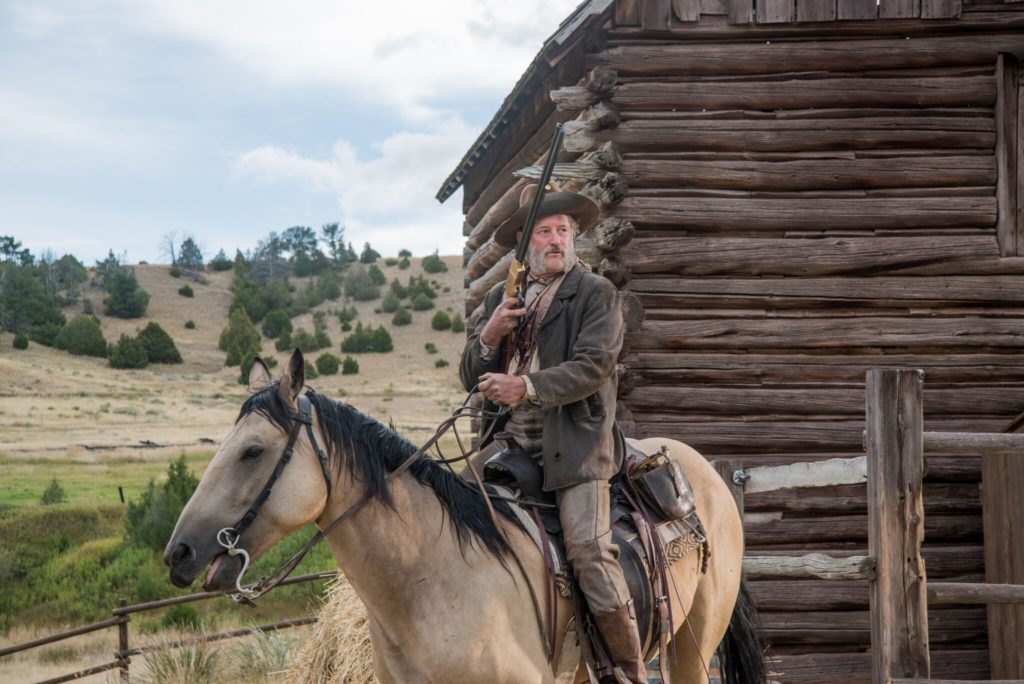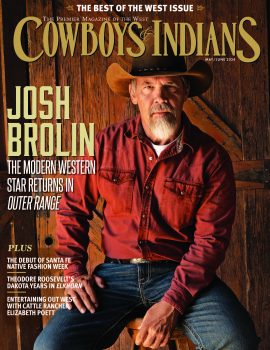Bill Pullman stars as a longtime sidekick turned improbable hero in the western drama.
Whatever you do, don’t mistake writer-director Jared Moshe for some tenderfoot looking to make a name for himself in the western genre. The Ballad of Lefty Brown — his latest film, now available on streaming platforms and in limited theatrical release — isn’t his first rodeo.
In 2012, he made his bountifully promising directorial debut with Dead Man’s Burden, an acclaimed western drama about violent clashes over a frontier homestead. (Chief among those caught in the crossfire: Clare Bowen of TV’s Nashville.) With Ballad of Lefty Brown, he more than makes good on that promise with an even more engrossing sagebrush saga.
A resounding hit with critics and audiences when it premiered last spring at Austin’s SXSW Film Festival, the beautifully photographed indie production — which was shot on location in and around historic Bannnack, Montana — is a solidly crafted and impeccably acted crowd-pleaser starring Bill Pullman (pictured above), the prodigiously versatile actor whose credits range from Independence Day to the recently released Battle of the Sexes. Pullman — who just happens to own and maintain a ranch in Whitehall, Montana — is cast to perfection as Lefty Brown, the grizzled sidekick of a Wild West legend (Peter Fonda) who must stand on his own, and go gunning for justice, when that legend is killed.
We got to visit with Jared Moshe a few days ago as he traveled along the promotional trail for his new western. Here are some highlights from our conversation.
Cowboys & Indians: Some filmmakers complain about how long it takes for some actors to arrive on set. It must have been pretty sweet to have a star whose own ranch was so close to the ranch where you were filming.
Jared Moshe: Actually, he literally was closer than where we could put other people up. It took me 40 minutes to get to the set. It took him 20. But the funny thing is, it was totally the biggest coincidence in the world. I had gone to Montana on my first location scout, and I’d fallen in love with Bannack, the town, because it was historic, and it had never been filmed before. But the big holdup was, we couldn’t find a ranch. We drove all over the state trying to find the ranch, and literally, that was the last place we looked. It was the only one that worked — and it happened to be 20 minutes from Bill’s house. It's crazy. I mean, it’s kismet.
C&I: Better still, you had a lead actor who already knew how to cowboy up and work a ranch.
Moshe: Yeah, and I think that's really important for a western. I mean, when you're casting, you really want the characters who are supposed to know how to ride, to be played by actors who know how to ride. Because I think it reads as false when you have someone who hasn’t spent the time in the saddle, who is not comfortable on a horse. Who doesn't have the intimate knowledge of what it takes to be a rider. But what also was wonderful about working with Bill was, he knew all about ranch life as well. As we were working through the script together, we’d be talking about how something would be done. He would explain how he would do it on his ranch, and then we would incorporate that into the story a little bit. Like, when he’s fixing the post at the beginning, we talked about how he would do it, what he would do in that scene. So we really seized on that knowledge he had.
C&I: The Ballad of Lefty Brown is in most respects a traditional, even classic western story. But you give it a very intriguing twist: In this Wild West tale, the sidekick takes center stage. It’s almost as if you made a movie in which John Wayne got waylaid early on, and Walter Brennan or Gabby Hayes had to go gunning for revenge.
Moshe: For me, Lefty is a lot like Walter Brennan in Rio Bravo. Think about it: He’s played for comedy. The audience laughs at him, the other characters laugh at him, everyone laughs at him. He’s joke, right? But he’s also the person who John Wayne puts in the jail cell to guard the prisoner, and is the last line of defense. In case it all goes wrong, it’s Walter Brennan who has to take care of it. Why do you have this character who is both someone we see as a joke, but also someone John Wayne trusts with a very important task? Trying to figure that out, that sort of dichotomy, is really what inspired me to write this story.
C&I: Of course, for a long time, we don’t really know if Lefty is up to the task he’s assumed for himself. That adds a great deal of suspense to the story, the whole question of whether, when push comes to shove, he’ll really be capable of doing what a man’s got to do.
Moshe: I think that’s a question that even Lefty doesn’t know the answer to. For me, I think being a sidekick was a conscious choice for him, to be 100 percent honest. I think, early on, he decided that it was easier to be a sidekick, to not have to make the tough decisions. John Wayne — or, in this case, Edward Johnson — is the person who has to hang people. Edward Johnson is the person who has to go out and make the hard decisions — if someone needs to die, if someone needs to live. Lefty just sort of does what he’s told. It protects him from the darkness of the world, and the harshness of the world, when you’re in that position.
And if you notice, he’s still trying, through most of this movie, to be a sidekick. He keeps falling into that role, and wanting to be that role. If there were someone else who would take care of this for him, he would gladly let them do it. The fact that he decides to do it himself — that he realizes what he’s capable of — is a real coming-of-age moment for him.
Bill and I talked about that a lot when we were working through the script, all the moments where Lefty’s looking for a way out. The little moments where, God, if he could just turn and go away or just find a new partner — but he can’t. You know, it’s both because there’s something inside of him that he doesn’t even realize is there, and because he’s being pushed forward by the circumstances around him.
C&I: The only real downside is, in order for Lefty Brown to become his own man, Edward Johnson has to be taken out of the picture fairly early in the story. Maybe a prequel … ?
Moshe: I’d love to do a prequel. It’d be so much fun to get everyone together and do a prequel.
C&I: Because just the short amount of time that Bill Pullman and Peter Fonda get to work together leaves you thinking, “Oh, I want more of this relationship. I want more of this partnership.”
Moshe: Well, that's what we intended. We really want to leave people, when Peter dies, wanting more of that relationship. I think that's important, you know? You want that sense of loss. You want to feel that love, and how great they are together. So that when he dies, it is both shocking and tragic — and leaves you wanting more.
C&I: When you think about it, it was absolutely essential to have someone like Peter Fonda play Edward Johnson, to make that much of an impact in such little time on screen. Somebody who has been in other westerns — and whose father, of course, was in many great westerns. Somebody with that kind of stature to make it, as you say, all the more shocking when he is killed.
Moshe: Absolutely. For us, that was a really important role to cast. We needed an actor who, if you were going to make a movie poster, he would in a certain way be the center of that poster, even for such a short role. We were looking at a lot of names, and we thought of Peter Fonda because he has been so tied into the genre, like very few people today really are. If you remember, the first film he directed, The Hired Hand, was a western. It was such a wonderful moment when we realized he liked the script and liked the role and was very excited about it. Because, yes, it is a short role, but it has a presence that’s felt throughout the entire movie, and Peter saw that.
C&I: Actually, the casting is pretty terrific all the way down the line in The Ballad of Lefty Brown. Kathy Baker as Laura Johnson, Edward Johnson’s wife, is another standout. You get the feeling that she was a loyal and supportive wife and partner during their marriage — but, like Lefty, she also is tough enough to handle the demands that fall on her after he’s out of the picture.
Moshe: Kathy was a joy to work with, and we were lucky to get her. It blows my mind that she has not been cast in a western before this. When we first talked about the role with her, I remember telling her that, in a lot of ways, she was based on Mary Ann Goodnight, Charles Goodnight’s wife, who was a ranch woman who saw her best friend once a year, who lived alone basically with a ranch full of men. That strength to survive in this world, Kathy conveyed it with such skill.
C&I: What is it about the western genre that has so captured your fancy?
Moshe: I think it’s kind of the myth of America. It’s how we define ourselves so much as a people. It’s this place where myth and history meet, and form the understanding of our identities of who we are as a country. That sense is so ingrained in us. And yet, we also realize how brutal and violent and dark it was back then. I’ve sort of been drawn to that world because I love playing with history and mythology, and how they’re both things that help us identify who we are individually, and who we are as a culture. It gives our culture a sense of purpose. All our sense of good and bad sort of stems from there.
C&I: So can we expect — do we dare hope for — a third western from you anytime soon?
Moshe: [Laughs] I have a sci-fi script I’m actually trying to put together. But, yeah, I have another western I want to do that’s in the back pocket. I was actually at a party the other week, and I met Quentin Tarantino for the first time. It was me, Quentin Tarantino, and Walter Hill talking, and Quentin said that to be a western filmmaker nowadays, you need to make three westerns. I think he's right, so I have a third one in the pipeline.














